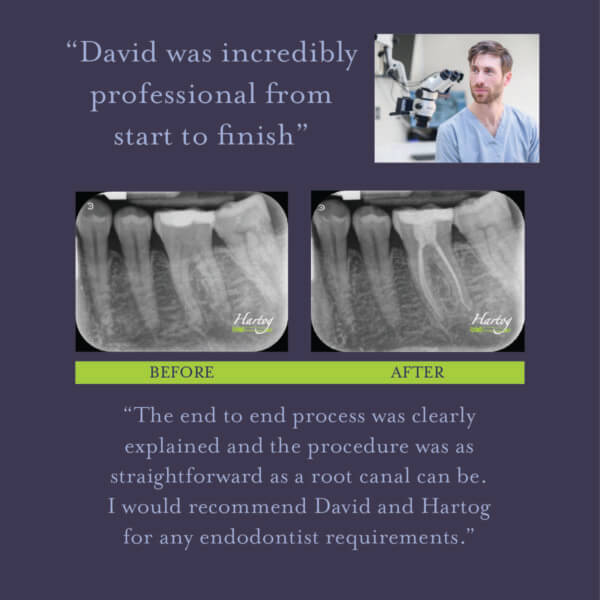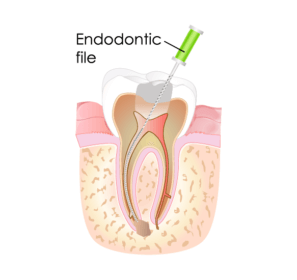The aim of root canal (endodontic) treatment is to save teeth that might otherwise face removal, here at Hartog Dental we pride ourselves in our root canal treatment being painless, comfortable and efficiently carried out.
We offer Endodontic Treatments / Root Canals to Hartog Dental patients, or you can self-refer (just get in touch), or be referred by your existing dentist (Learn More / Make a referral).
A “root canal” is not a treatment, but part of a tooth. It is the hollow section of a tooth that contains the nerve tissue, blood vessels, and other cells, also known as the pulp.
A tooth consists of a crown and roots. The crown is mainly above the gum, while the roots are below it. The roots attach the tooth to the jaw bone via a ligament called the periodontal ligament. This ligament can become damaged as a result of trauma or bacterial invasion, this can sometimes be seen on an X-ray (2D) or CBCT (3D) which is why these might be taken at your appointment.
nside the crown and the root, within the root canal lies the pulp. This pulp when healthy, nourishes the tooth but when diseased or infected by bacteria can cause toothache, tenderness and even lead to loosening the tooth.
The name of the dental procedure commonly referred to as a “root canal” is actually endodontic therapy, which means “inside the tooth.” It involves the meticulous cleaning, shaping and filling of this little tiny space within the tooth that once housed the healthy pulp tissue within the tooth crown and roots. Teeth vary enormously and can have many different numbers of roots, however the precise number and location can be found by using CBCT (3D) scanning images and the use of an operating microscope.

Root canal therapy is done in three steps, and it usually takes between one and three sessions to complete.
First, we remove everything that is inside the root canal. We make a tiny access hole on the surface of the tooth with our state of the art operating microscope to remove the diseased and dead pulp tissue with tiny files.


Next, we clean, shape and decontaminate the hollow area, using tiny files and irrigation solutions. The tooth is filled with a rubber-like material, using an adhesive cement to seal the canals completely. After root canal therapy, the patient will no longer feel any pain in that tooth because the nerve tissue has been removed, and the infection has been eliminated.


The final stage is to make the tooth strong again. A crown (a cover on a tooth) resembles a tooth and is permanently cemented on. Crowns are custom fit to each tooth and the shape and color can be customized to maximize its aesthetics. Crowns surround teeth circumferentially and cover the chewing surface. This reduces stress on a weakened tooth and protects it against trauma and chewing forces.
Our Endodontists are delighted to be able to treat your NHS patients using Individual Funding Requests (IFRs) which we can assist with.
Dental trauma is relatively common, it has been reported to occur in as many as 20% of the population.
We use advanced 3D CBCT scans to help diagnose the severity of the dental injury. In our experience these types of injuries often require a multi-disciplinary approach, for example, deciding on orthodontic treatment to realign teeth which might have been accidentally knocked out of place, or even the necessity of an implant versus retaining the tooth.
When required, root canal treatment is carried out as soon as practically possible. However, in many instances, we can carry out minimally invasive pulp cap treatment to preserve the healthy tooth and its pulp tissues (nerve and blood supply), thus avoiding root canal work.
Traumatised teeth may discolour with time, particularly if they are poorly root-treated; we offer focused whitening treatments to improve the appearance of discoloured individual teeth.
Speak to us today to learn how Root Canal (Endodontic) Therapy will work for you, how they can relieve pain and give you back your smile.
Preservation of Natural Tooth: Rather than extracting the tooth, root canal therapy aims to save it, maintaining the integrity of your natural smile.
Prevention of Further Infection: By removing the infected or damaged pulp and sealing the tooth, root canal therapy helps prevent the spread of infection to surrounding teeth and tissues.
Improved Oral Health: Restoring the health of the tooth through root canal therapy contributes to overall oral health, reducing the risk of complications and the need for more extensive dental treatments in the future.
Functional Restoration: After root canal therapy, the treated tooth can continue to function normally for biting and chewing, preserving your ability to eat comfortably.
Cosmetic Benefits: Root canal therapy can also have cosmetic benefits by maintaining the appearance of your natural teeth and preventing gaps in your smile that may occur with tooth extraction.
Long-Term Solution: With proper care, a tooth treated with root canal therapy can last a lifetime, providing a long-term solution to dental problems.